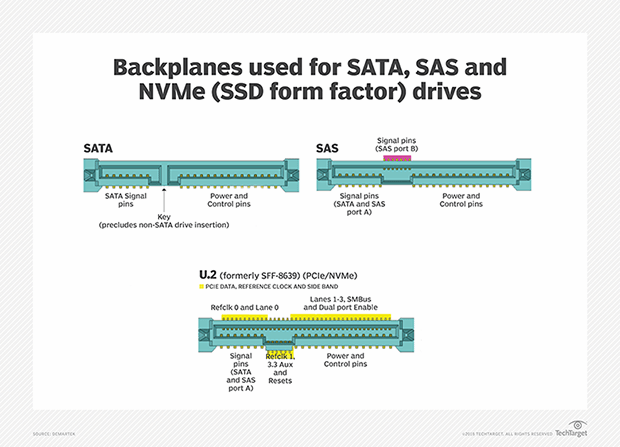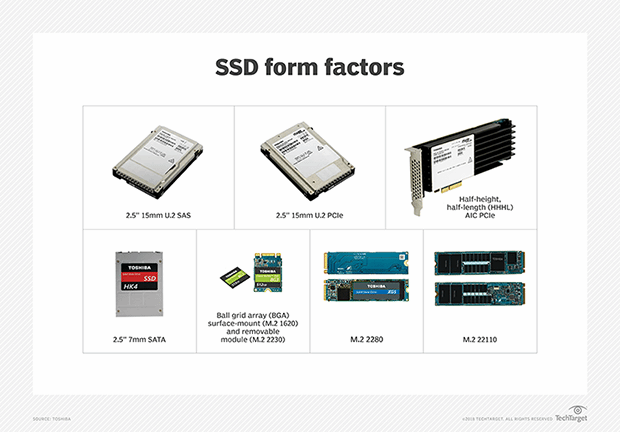What is U.2 SSD (formerly SFF-8639)?
A U.2 SSD is a high-performance data storage device designed to support the Peripheral Component Interconnect Express (PCIe) interface using a small form factor (SFF) connector that is also compatible with standard SAS and SATA-based spinning disks and solid-state drives (SSDs). U.2 is a hardware interface for connecting drives, particularly nonvolatile memory express (NVMe) SSDs, to a computing device over the PCIe bus.
U.2 and SSDs
SSDs can be attached to host systems via one of three interfaces: SATA, SAS and NVMe. NVMe technology, a type of logical interface, can speed the transfer of data between host systems and SSDs over a PCIe interconnect.
Although U.2 SSD technically could describe a PCIe, SAS or SATA drive, manufacturers generally use the term only to describe a 2.5-inch PCIe SSD that supports the NVMe host controller interface and storage protocol. U.2 in the 2.5-inch form factor is the most common deployment for SSDs and is typically used with desktops and servers.
The original name of the U.2 interface was SSD Form Factor-8639 (SFF-8639). The SSD Form Factor Working Group (SFFWG) changed this cumbersome name to the simpler U.2. The main impetus for its development was to enable the newer and faster NVMe-based PCIe SSDs to plug into the same drive backplane as legacy SAS and SATA drives without the need to shut down an enterprise server and storage system to insert or remove the drives.
History of the U.2 form factor
The SFFWG comprised vendors with commercial interests in SSD technology and was formed in 2010 to promote PCIe as a high-speed interconnect. Group members developed a connector specification to enable PCIe to interoperate with the SAS and SATA storage protocols in a disk enclosure designed for standard 2.5-inch or 3.5-inch hard disk drives (HDDs). The specification defines the physical connector's mechanical and electronic properties, power profiles and hot-plug design. The U.2 interface is hot-swappable, supports PCI Express, SATA and SAS drives, uses 2.5-inch and 3.5-inch housings for large-capacity SSDs and has its own pin configuration.
Founding members of the SFFWG that developed the U.2 connector specification included Dell and EMC -- before the companies merged -- Fujitsu, IBM and Intel. Other contributing members included the following:
- Amphenol.
- Emulex (acquired by Broadcom in 2015).
- Fusion-io (acquired by SanDisk in 2014, which in turn was acquired by Western Digital in 2016).
- Integrated Device Technology (acquired by Renesas in 2018).
- Marvell.
- Micron.
- Molex.
- PLX Technology (acquired by Broadcom in 2014).
- QLogic (acquired by Cavium in 2016).
- SandForce (acquired by LSI in 2011, then by Seagate in 2014).
- Smart Modular Technologies.
- STec (acquired by Western Digital in 2013).
The SFFWG chose U.2 as the marketing term to describe PCIe, SAS and SATA profiles for the SFF-8639 connector. The SFF-8639 connector can support one SATA port, two SAS ports or up to four lanes of parallel I/O in PCIe SSDs.

Specifications following U.2
A subsequent SFF-9639 specification defines the pinout information for the various interfaces designed for use with the SFF-8639 connector. Available profiles include U.3 and USB in addition to U.2's PCIe, SAS and SATA.
U.3, as the name suggests, is built on the U.2 specification. It uses the same SFF-8639 connector as U.2 and combines support for SATA, SAS and NVMe in a single controller. U.3 drives are backward-compatible with U.2. However, U.2 drives will not work with U.3 hosts.
The Storage Networking Industry Association SFF Technology Affiliate (TA) Technical Work Group (TWG) now has responsibility for the SFF-9639 specification after merging with the group that did the original work on the SFF-8639 and SFF-9639 connectors. In addition to making revisions to the SFF-8639 and SFF-9639 (SFF-8xxx and SFF-9xxx) connections, the SFF TA TWG also develops technical specifications for storage media and storage networks that complement existing industry standards.
Advantages of U.2 SSDs
One of the main advantages of U.2 SSDs over typical add-in cards that plug in to a computer's internal PCIe bus is that users do not need to open a server to insert or remove them. They are hot-pluggable whether or not the system receives prior notification, just like SATA and SAS SSDs and HDDs. U.2 is also hot-swappable since it connects to the motherboard via a cable, making it easy to remove or replace the connectors as needed.
Another key advantage of the U.2 connector and form factor is backward compatibility with HDDs. Server and storage manufacturers are able to configure enterprise systems with a mix of 2.5-inch or 3.5-inch HDDs and PCIe-, SAS- and SATA-based U.2 SSDs to suit the needs of their customers. The system's backplane must be designed to support NVMe in order to use the NVMe-based PCIe SSDs.
A U.2 SSD supports up to four lanes of parallel I/O over a PCIe connection in an enterprise server or storage system. With a dual-controller storage array, a pair of two-lane PCIe links would operate independently of each other, allowing for the failure of one controller. A defined signal on the SFF-8639 connector indicates to the drive whether to operate in single- or dual-port mode.
The U.2 SSD specification offers optional support of the System Management Bus protocol to monitor the voltage and temperature of the motherboard's control or system management controller.
Drawbacks of U.2 SSDs
The main disadvantage of U.2 SSDs is the higher cost of the drive technology, including the SFF-8639 connector, so users need to determine if they need the higher performance and lower latency that NVMe-based PCIe SSDs can enable.
Enterprise users also may need to buy new servers designed to support U.2 SSDs, since legacy infrastructures may not be equipped with the SFF-8639 connector technology. Further, U.2 drives are not compatible with U.3 hosts, so U.2 NVMe drives cannot be used in a U.3 drive bay, even though the connectors are the same.
U.2 SSD vs. M.2
M.2 SSDs are gaining popularity in conjunction with the escalating interest in high-performance, low-latency NVMe technology. The M.2 specification supports PCIe, SATA and USB interfaces.
SFF M.2 SSDs were originally designed for thin, power-constrained devices, such as tablet computers and laptops. Single-port M.2 SSDs may also be used as boot devices and storage drives in web and other servers that do not require dual-ported drives for enterprise use.
M.2 SSDs offer up to 6X higher speeds than standard HDDs. Manufacturers produce M.2 SSDs in a variety of sizes, , although the most common is 22 mm in width and lengths of 60 mm, 80 mm or 110 mm. In contrast, U.2 SSDs are designed to plug in to the 2.5-inch and 3.5-inch slots in the backplanes of enterprise server and storage systems.

U.2 SSDs also accommodate a higher maximum storage capacity than M.2 SSDs as a result of their larger physical size. Despite their smaller size, M.2 connectors take up a larger footprint on the motherboard compared to U.2 connectors. Additionally, they can be hard to replace or remove (not hot-swappable) since they are fixed directly to the motherboard. There are, however, some types of M.2 SSDs that can be swapped in or out of a running computer system, as long as the system layout enables open access to the M.2 SSDs.
Because the U.2 form factor is larger than M.2, it is more conducive to heat dissipation and permits higher operating temperatures without damaging the drive components. This feature prevents the drive's performance from being throttled or impeded when it heats up, which can happen during write-intensive operations.
Uncover the widespread use of flash memory across a wide range of consumer goods, from smartphones to USB memory cards. Gain insight into the different types of flash memory, its diverse applications and its future trends.





